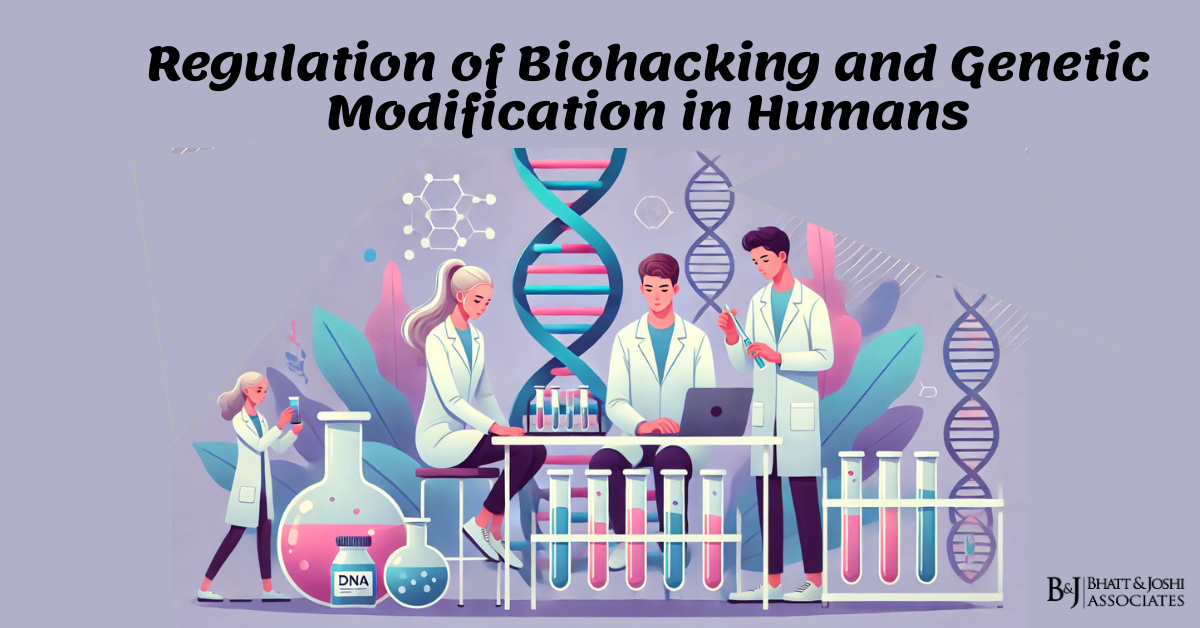Introduction
Biohacking and human genetic modification represent two pillars of innovation that defy conventional legal, ethical and regulatory bounds. Biohacking refers to self-performed biological experimenting with the intent of augmenting one’s physical or cognitive attributes. On the other hand, genetic modification is the manipulation of an organism’s DNA to achieve certain results, such as curing genetic illnesses or improving human features. Although these specialized fields offer a lot, they also pose serious issues regarding safety, ethics, and societal consequences. The attention of this article is focused on the regulatory framework of biohacking and genetic modification, focusing on highlights of legislation, case laws and court decisions affecting those biohacking and genetic alteration practices.
Biohacking: Scope and Challenges
Biohacking encompasses a range of activities, from wearable technology and dietary adjustments to advanced practices like implanting microchips or experimenting with gene-editing techniques. The practice often operates in a regulatory grey area due to its grassroots nature and rapid technological advancements. It is driven by individuals or small groups rather than large institutions, which complicates oversight and accountability. Moreover, the lack of standardized practices increases the risk of unsafe experimentation.
Regulatory Framework for Biohacking
Biohacking involves an amalgamation of multiple overlapping categories like health law, safety law, and laws protective of consumers. The United States has an important agency, the FDA, which together with medical devices, drugs, and biological products also regulates biohacking tools and techniques. If a device or technique of biohacking falls within the definition of a medical device, then that device or technique has to follow FDA regulations about safety and efficacy. There are other agencies as well, for instance, the FTC, which deals with biohacking through regulating false advertising of biohacking tools. Biohackers who operate on genetic engineering or self-prescribed treatments may also fall within the jurisdiction of the NIH or CDC with respect to public health.
In the EU, biohacking activities are controlled under GDPR should there be personal health data involved. As an additional source, the EMA supervises medicinal actions, which may stem from biohacking as well. Within member states of the EU, there can be additional national legislation which is likely to differ based on the ethical and cultural views of biohacking.
Case Laws and Legal Precedents of Biotechnology
Innovative applications of biotechnology have expanded beyond the boundaries of scientific institutions resulting in biohacking, which is an uncontrolled premise that blurs the lines of legality. Most legal discussions regarding biohacking focus on cases of misuse of devices that are not controlled or Procedures that are not regulated. In United States V. Vascular Solutions, Inc. (2016), the court underlined the potential legal consequences of off-label marketing of medical devices through indirect FDA biohackers marketing unregulated products. A similar legal consequence was in State V. Andrews (2018), where a biohacker was prosecuted for microchipping humans without a proper medical license, demonstrating the illegality of reckless work. This demonstrates the importance of controlled medical and safety measures for, even in the face of self-experimentation, biohackers are liable for the rules that govern medicine.
Ethical and Safety Concerns
Biohacking raises significant ethical issues, such as informed consent and the potential for harm. The lack of formal oversight can lead to unsafe practices, as demonstrated by the 2018 death of a biohacker who injected himself with an untested herpes treatment. The incident spurred calls for stronger regulatory oversight and highlighted the dangers of circumventing established medical procedures. Ethical questions also arise around issues of equity, as biohacking technologies may exacerbate social inequalities if only accessible to wealthy individuals or groups. Regulatory bodies worldwide are grappling with these challenges, attempting to balance innovation with public safety.
Genetic Modification: Legal Landscape
Genetic modification in humans, particularly through technologies like CRISPR-Cas9, has the potential to eradicate genetic diseases and enhance human abilities. However, it also raises concerns about eugenics, equity, and unintended consequences. The dual-use nature of these technologies, where tools intended for therapeutic purposes can also be employed for enhancement or harmful objectives, complicates regulatory oversight.
International Frameworks
Regulation of genetic modification worldwide is under treaties and conventions. The 1997 UNESCO Universal Declaration on the Human Genome and Human Rights focuses on the ethical issues of genetic interventions, which can potentially harm human dignity, and hence, tries to prevent such interventions. The Council of Europe’s Oviedo Convention has a similar approach as it prohibits all genetic modifications that seek to change the genome of future generations. These international documents, general in character, are left for domestic action by states, which results in gaps in adherence and enforcement.
National Regulations
The FDA, National Institutes of Health (NIH), and the Department of Agriculture (USDA) have joint jurisdiction over genetic modification within the United States. The NIH’s Recombinant DNA Advisory Committee (RAC) provides oversight over human genetic research and issues such as human recombinant DNA usage, but the absence of legislation modifying humans has given rise to concerns. Though some states are claiming their jurisdiction with legislation, it is problematic due to the lack of cohesive agreement at the national level.
After researcher He Jiankui infamously attempted to create genetically modified babies with CRISPR technology in 2018, China’s policy on genetic modifications began to receive more attention. As a follow-up to this event, China implemented strict regulations including a ban on unauthorized genetic modifications on humans. On the other hand, the European Union takes a more guarded stance as demonstrated by their Clinical Trials Regulation (CTR) and EU Charter of Fundamental Rights. Countries Germany and France have further restrictions due to their historical experience with eugenics.
Case Laws and Judicial Precedents of Genetic Modification
The He Jiankui case in China serves as a salient example of how the law addresses genetic modification. The researcher got a three-year sentence and was charged for “illegal medical practices,” which demonstrates the government’s willingness to intervene in ethical issues in genetic science. In the U.S., Greenwood Genetic Center v. GeneDX (2007) dealt with the patentability of genetic tests, which affected the commercialization of genetic technologies in some way. Even if the case did not pertain directly to human alteration, it did deal with the legal aspects of genetic innovations.
The hallmark decision of the Association for Molecular Pathology v. Myriad Genetics, Inc. (2013) case by the U.S. Supreme Court ruled out the possibility of patenting natural DNA sequences, thus fostering a conducive environment for genetic research and alteration. This ruling reaffirmed the need to strike the right balance between technology advancement and accessibility. This concern was rendered in the same year in the Brüstle v. Greenpeace e.V. (2011) case of the European Court where the ban on patenting human embryonic stem cells highlighted the need to maintain some boundaries about ethical treatment of people in the name of science.
Ethical Implications of Genetic Modification
The ethical dilemmas surrounding genetic modification include the potential for designer babies, genetic discrimination, and the exacerbation of social inequalities. The use of genetic technologies in a manner that prioritizes enhancement over therapeutic purposes is particularly contentious, prompting calls for stringent ethical oversight. The debate extends to the concept of “playing God” and the unforeseen consequences of altering the human genome, which could have multi-generational effects.
Judicial Perspectives and Landmark Judgments
With biohacking and genetic modification evolving, legal courts around the globe had to look into its consequences more deeply. Kunal Saha v AMRI Hospitals Ltd (2013) multiplied the need to obtain consent with any medical intervention and accountability of the professionals who are providing medical services, and this has happened regarding biohacking and genetic modification as well. This judgment made sure that ethics was defined and patient safety was given priority even when the circumstances were experimental.
Similar landmark decisions like R. v. Adams (UK, 1996) also focused on the concept of informed consent and regulations on compliance. These matters cumulatively strengthen the point of the importance of the legal system regarding emerging potential technologies.
Balancing Innovation and Regulation
The rapid pace of innovation in biohacking and genetic modification poses a challenge for regulatory frameworks that often lag behind technological advancements. Striking a balance between fostering innovation and ensuring public safety requires a multi-faceted approach. Governments, international organizations, and the scientific community must collaborate to address these challenges effectively.
Policy Recommendations for Biohacking and Genetic Modification
To create coherent standards for biohacking and genetic modification, there needs to be international regulation. The public should be part of the conversation when dealing with ethical issues so that trust can be built in regulation frameworks. More transparency in genetic research and biohacking can boost accountability and minimize risks. Independent committees can also be set up to monitor riskier undertakings, experiments, and innovations. A more educated public on these technologies will help in making informed choices about them.
Future Directions
Emerging technologies, such as gene drives and synthetic biology, will further complicate the regulatory landscape. Anticipatory governance—the proactive regulation of emerging technologies—may offer a viable solution to address these challenges. Regulatory bodies must remain adaptable, incorporating feedback from ongoing scientific and societal developments.
Conclusion
The issue of biohacking and human genetic modification is multifaceted and continually develops as it overlaps with the spheres of law, ethics, and public policy. These technologies, while capable of creating great change, also come with major threats, thus a form of regulatory framework is important. Society can address these innovations using existing laws, judicial decisions, and ethical norms assuring that these innovations are dealt with fairly and responsibly. It is the hope that innovation can flourish within the appropriate restrictions of human dignity and polity. The expansion of international relations as well as new frameworks of ethical norms will be essential for the effective management of these advanced technologies for the sustainable development of society.













